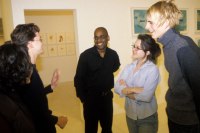Glenn Ligon’s residency had two distinct elements that nevertheless shared a common theme of “sampling”—the contemporary method of cutting and mixing existing material and ideas to create something dynamic and new. Fascinated by the complicated histories—social, cultural, and political—that can be traced through the covers of books by and about African Americans, Ligon spent many hours exploring the stacks in the Archie Givens Sr. Collection of African American Literature at the University of Minnesota. He later assembled more than sixty of these covers in a small exhibition at the Walker. His display told a fascinating story of the changing representations of black subject matter from the 1950s to the 1970s, a time roughly parallel to the rise of the Civil Rights and Black Power movements, and then carried it forward with books from the 1980s to the close of the twentieth century. His selections and groupings, juxtaposed with his own commentary and quotes by writers such as LeRoi Jones, James Baldwin, and Oscar Wilde, were highly personal yet open to interpretation, and ranged from close-ups of black faces to the coding of blackness in typography and graphic layouts.
For the second part of his residency, Ligon asked Walker Art Center Teen Arts Council members to respond to various artworks in the Walker’s permanent collection by sampling them to make their own individual pieces. Over a four-month period, the teens worked closely with Ligon to develop their ideas, gaining insight into the creative process. They drew on artists as varied as Lucio Fontana, Andy Warhol, Charles Ray, and Kara Walker. . . .
For the second part of his residency, Ligon asked Walker Art Center Teen Arts Council members to respond to various artworks in the Walker’s permanent collection by sampling them to make their own individual pieces. Over a four-month period, the teens worked closely with Ligon to develop their ideas, gaining insight into the creative process. They drew on artists as varied as Lucio Fontana, Andy Warhol, Charles Ray, and Kara Walker. . . .
Artist's Statement
"We all know that kids' drawings are great. But why are they great? Part of it has to do with the delight they experience making something, a delight that shows in the work. I also love children's drawings because kids' relationship to culture, language, and identity is not yet fixed. They haven't yet ingested all the rules and prohibitions adults have, so there is no one way that things have to be in their drawings."—Glenn Ligon





